

On 19 May KVERT reported that the eruption at Kambalny likely had ended, with only gas-and-steam activity observed during the previous month. The explosive phase began on 24 March and ended on 10 April. The Aviation Color Code was lowered to Green.
Source: Kamchatkan Volcanic Eruption Response Team (KVERT)
First major eruption in over 600 years consists of large ash explosions during March-April 2017
The last major eruption at Kambalny volcano was around 1350, although younger undated tephra layers have been found; there are also five Holocene cinder cones on the W and SE flanks. According to the Kamchatkan Volcanic Eruption Response Team (KVERT), a new eruption began began at about 2120 UTC on 24 March 2017. Satellite data showed an initial ash plume at about 5-6 km altitude drifting about 35 km SW from the volcano.
Explosive activity was strong during 24-27 March, generating ash plumes up to 7 km high that drifted downwind as far as 2,000 km (table 1). Activity then decreased, with only minor ash emissions through 6 April, followed by ash plumes that drifted 50 and 170 km on 9 and 10 April, respectively. Only gas-and-steam plumes were reported after that time.
Table 1. Chronological details of the March-April 2017 eruption of Kambalny. Data from KVERT reports.
| Date | Time (UTC) | Plume height (km) | Drift (km) | Other observations |
| 24 Mar 2017 | 2250 | 5-6 | 35 SW | Aviation Color Code Orange |
| 25 Mar 2017 | 0053 | 5-6 | 100 SSW | -- |
| 25 Mar 2017 | 0240 | 5-6 | 163 SSW | -- |
| 25 Mar 2017 | 0409 | 5-7 | 255 SW | -- |
| 25 Mar 2017 | 1250 | 5 | 550 SSW | -- |
| 25 Mar 2017 | 1807 | 6 | 870 SSW | -- |
| 25 Mar 2017 | 2250 | 5.5 | 930 S | -- |
| 26 Mar 2017 | 0530 | 5 | 1,350 SSE | -- |
| 26 Mar 2017 | 2131 | 3.5-4 | 670 SE | -- |
| 27 Mar 2017 | 0041 | 5 | 830 SE | -- |
| 27 Mar 2017 | 0347 | 4-4.5 | 425 SE | -- |
| 27 Mar 2017 | 2119 | 4-5 | 51 W | -- |
| 27-31 Mar 2017 | -- | 5-6 | 2,000 W to SE | -- |
| 01 Apr 2017 | -- | -- | 200 E, SE | Quiet. |
| 02-04 Apr 2017 | -- | 7 | -- | Minor ash emissions thru 6 Apr; satellite thermal anomaly 3-4 Apr. |
| 09 Apr 2017 | -- | 7 | 50 NE | -- |
| 10 Apr 2017 | -- | -- | 170 SE | -- |
| 12 Apr 2017 | -- | -- | -- | Gas-and-steam activity. |
| 21-28 Apr 2017 | -- | -- | -- | Moderate activity. |
| 05 May 2017 | -- | -- | -- | Aviation Color Code Yellow. Moderate gas-steam activity. |
| 19 May 2017 | -- | -- | -- | Aviation Color Code Yellow Green. Only gas-steam activity during last month; explosive phase began 24 Mar, ended 10 Apr 2017. |
On 25 March satellite imagery showed an ash plume stretching about 100 km SW of the Kamchatka Peninsula (figure 1). A dark stain is visible to the W of the plume, where ash has covered the snow. By 26 March ashfall had covered the ground on both sides of the volcano. The eruption was also observed on the ground by staff at the South Kamchatka Federal Wildlife Sanctuary (figure 2). The Ozone Monitoring Instrument on the Aura satellite observed an airborne plume of sulfur dioxide (SO2) trailing S of Kamchatka on 26 March 2017 (figure 3).
 |
Figure 2. Eruption of Kambalny on 25 March 2017. Photo by Liana Varavskaya, South Kamchatka Federal Wildlife Sanctuary (URL: http://www.kronoki.ru/news/1187). |
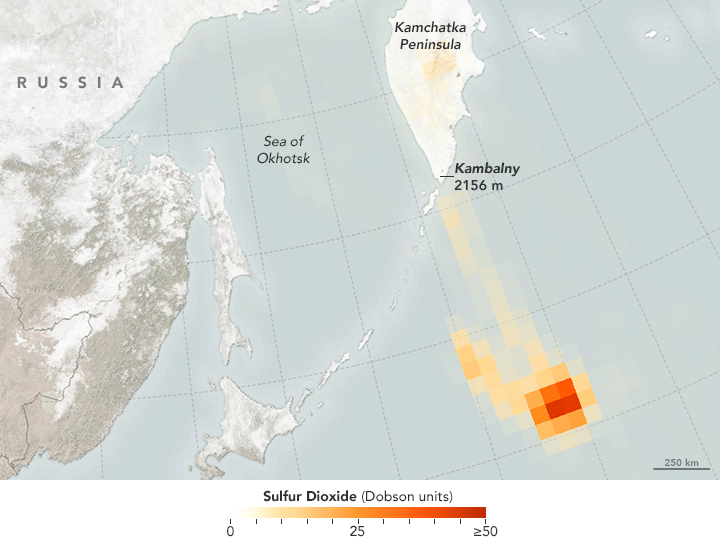 |
Figure 3. Sulfur dioxide in the 26 March 2017 plume from Kambalny eruption. Courtesy of NASA Earth Observatory; map by Joshua Stevens using data from the Aura OMI science team. |
On 28 March 2017, the Operational Land Imager (OLI) on the Landsat 8 satellite acquired a natural-color image of an ash plume from Kambalny (figure 4), including a large area of ash-covered snow. When photographed by scientists on 12 April (figure 5), the entire edifice was covered by ash and there was a gas-and-steam plume rising from a crater fumarole.
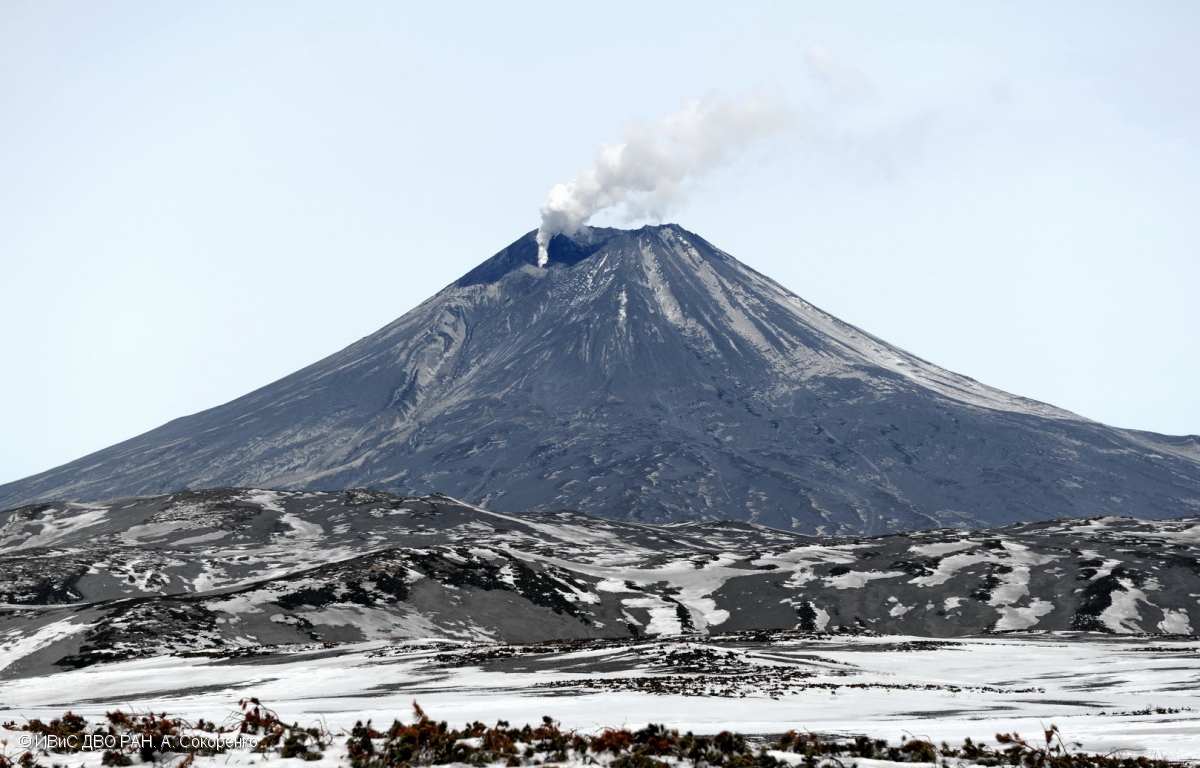 |
Figure 5. A small gas-and-steam plume rises from a fumarole in the Kambalny crater on 12 April 2017. View is from the S. Photo by A. Sokorenko; courtesy of IVS FEB RAS. |
Information Contacts: Kamchatka Volcanic Eruptions Response Team (KVERT), Far Eastern Branch, Russian Academy of Sciences, 9 Piip Blvd., Petropavlovsk-Kamchatsky, 683006, Russia (URL: http://www.kscnet.ru/ivs/kvert/); Institute of Volcanology and Seismology, Far Eastern Branch, Russian Academy of Sciences, (IVS FEB RAS), 9 Piip Blvd., Petropavlovsk-Kamchatsky 683006, Russia (URL: http://www.kscnet.ru/ivs/eng/); South Kamchatka Federal Wildlife Sanctuary, Ministry of Natural Resources and Ecology of the Russian Federation, Kamchatka Territory 684000, Russia (URL: http://www.kronoki.ru/); NASA Earth Observatory, EOS Project Science Office, NASA Goddard Space Flight Center, Goddard, Maryland, USA (URL: http://earthobservatory.nasa.gov/); NASA Goddard Space Flight Center (NASA/GSFC), Global Sulfur Dioxide Monitoring Page, Atmospheric Chemistry and Dynamics Laboratory, 8800 Greenbelt Road, Goddard, Maryland, USA (URL: https://so2.gsfc.nasa.gov/).
On 19 May KVERT reported that the eruption at Kambalny likely had ended, with only gas-and-steam activity observed during the previous month. The explosive phase began on 24 March and ended on 10 April. The Aviation Color Code was lowered to Green.
Source: Kamchatkan Volcanic Eruption Response Team (KVERT)
On 5 May KVERT reported that conditions at Kambalny were quiet the previous week. The Aviation Color Code was lowered to Yellow.
Source: Kamchatkan Volcanic Eruption Response Team (KVERT)
KVERT reported that moderate levels of activity at Kambalny continued during 21-28 April. The Aviation Color Code remained at Orange.
Source: Kamchatkan Volcanic Eruption Response Team (KVERT)
KVERT reported that moderate activity at Kambalny continued during 15-21 April. Observers in the South Kamchatka Sanctuary noted minor ashfall in the Kurilskoe Lake area on 19 April. The Aviation Color Code remained at Orange.
Source: Kamchatkan Volcanic Eruption Response Team (KVERT)
KVERT reported that observers in the South Kamchatka Sanctuary noted an ash plume from Kambalny rising to an altitude of 7 km (23,000 ft) a.s.l. on 9 April. Ash plumes identified in satellite images drifted 50 km NE on 9 April and about 170 km SE the next day. The Aviation Color Code remained at Orange.
Source: Kamchatkan Volcanic Eruption Response Team (KVERT)
Based on satellite data, KVERT reported that Kambalny was quiet on 1 April. Explosions on 2 April generated ash plumes that rose to an altitude of 7 km (23,000 ft) a.s.l., and then minor ash emissions occurred at least through 6 April. Ash plumes drifted 200 km E and SE during 2-4 April, and a thermal anomaly was identified in satellite images during 3-4 April. The Aviation Color Code remained at Orange.
Source: Kamchatkan Volcanic Eruption Response Team (KVERT)
KVERT reported that the eruption that began at Kambalny at 2110 on 24 March continued through 31 March. Observers reported that explosions generated ash plumes that rose 5-6 km (16,400-19,700 ft) a.s.l. Satellite images showed ash plumes drifting 2,000 km W, SW, S, and SE during 24-30 March. The Aviation Color Code remained at Orange.
Source: Kamchatkan Volcanic Eruption Response Team (KVERT)
KVERT reported that the onset of an eruption at Kambalny, witnessed by staff at the Kronotsky State Nature Reserve, began at 0950 on 25 March. Satellite data showed an ash plume drifting 35 km SW at altitudes of 5-6 km (16,400-19,700 ft) a.s.l. The Aviation Color Code was raised to Orange (the second highest level on a four-color scale). The eruption intensified later that day, with ash plumes rising as high as 7 km (23,000 ft) a.s.l. and drifting as far as 255 km SSW. Ash plumes continued to be generated at least through 28 March, varying in altitude from 3.5-6 km (11,500-19,700 ft) a.s.l. and drifting as far as 1,350 km SSW, S, SSE, and SE during 26-27 March, and 51 km W on 28 March.
Sources: Kamchatkan Volcanic Eruption Response Team (KVERT); Kronotsky State Nature Reserve
Reports are organized chronologically and indexed below by Month/Year (Publication Volume:Number), and include a one-line summary. Click on the index link or scroll down to read the reports.
First major eruption in over 600 years consists of large ash explosions during March-April 2017
The last major eruption at Kambalny volcano was around 1350, although younger undated tephra layers have been found; there are also five Holocene cinder cones on the W and SE flanks. According to the Kamchatkan Volcanic Eruption Response Team (KVERT), a new eruption began began at about 2120 UTC on 24 March 2017. Satellite data showed an initial ash plume at about 5-6 km altitude drifting about 35 km SW from the volcano.
Explosive activity was strong during 24-27 March, generating ash plumes up to 7 km high that drifted downwind as far as 2,000 km (table 1). Activity then decreased, with only minor ash emissions through 6 April, followed by ash plumes that drifted 50 and 170 km on 9 and 10 April, respectively. Only gas-and-steam plumes were reported after that time.
Table 1. Chronological details of the March-April 2017 eruption of Kambalny. Data from KVERT reports.
| Date | Time (UTC) | Plume height (km) | Drift (km) | Other observations |
| 24 Mar 2017 | 2250 | 5-6 | 35 SW | Aviation Color Code Orange |
| 25 Mar 2017 | 0053 | 5-6 | 100 SSW | -- |
| 25 Mar 2017 | 0240 | 5-6 | 163 SSW | -- |
| 25 Mar 2017 | 0409 | 5-7 | 255 SW | -- |
| 25 Mar 2017 | 1250 | 5 | 550 SSW | -- |
| 25 Mar 2017 | 1807 | 6 | 870 SSW | -- |
| 25 Mar 2017 | 2250 | 5.5 | 930 S | -- |
| 26 Mar 2017 | 0530 | 5 | 1,350 SSE | -- |
| 26 Mar 2017 | 2131 | 3.5-4 | 670 SE | -- |
| 27 Mar 2017 | 0041 | 5 | 830 SE | -- |
| 27 Mar 2017 | 0347 | 4-4.5 | 425 SE | -- |
| 27 Mar 2017 | 2119 | 4-5 | 51 W | -- |
| 27-31 Mar 2017 | -- | 5-6 | 2,000 W to SE | -- |
| 01 Apr 2017 | -- | -- | 200 E, SE | Quiet. |
| 02-04 Apr 2017 | -- | 7 | -- | Minor ash emissions thru 6 Apr; satellite thermal anomaly 3-4 Apr. |
| 09 Apr 2017 | -- | 7 | 50 NE | -- |
| 10 Apr 2017 | -- | -- | 170 SE | -- |
| 12 Apr 2017 | -- | -- | -- | Gas-and-steam activity. |
| 21-28 Apr 2017 | -- | -- | -- | Moderate activity. |
| 05 May 2017 | -- | -- | -- | Aviation Color Code Yellow. Moderate gas-steam activity. |
| 19 May 2017 | -- | -- | -- | Aviation Color Code Yellow Green. Only gas-steam activity during last month; explosive phase began 24 Mar, ended 10 Apr 2017. |
On 25 March satellite imagery showed an ash plume stretching about 100 km SW of the Kamchatka Peninsula (figure 1). A dark stain is visible to the W of the plume, where ash has covered the snow. By 26 March ashfall had covered the ground on both sides of the volcano. The eruption was also observed on the ground by staff at the South Kamchatka Federal Wildlife Sanctuary (figure 2). The Ozone Monitoring Instrument on the Aura satellite observed an airborne plume of sulfur dioxide (SO2) trailing S of Kamchatka on 26 March 2017 (figure 3).
 |
Figure 2. Eruption of Kambalny on 25 March 2017. Photo by Liana Varavskaya, South Kamchatka Federal Wildlife Sanctuary (URL: http://www.kronoki.ru/news/1187). |
 |
Figure 3. Sulfur dioxide in the 26 March 2017 plume from Kambalny eruption. Courtesy of NASA Earth Observatory; map by Joshua Stevens using data from the Aura OMI science team. |
On 28 March 2017, the Operational Land Imager (OLI) on the Landsat 8 satellite acquired a natural-color image of an ash plume from Kambalny (figure 4), including a large area of ash-covered snow. When photographed by scientists on 12 April (figure 5), the entire edifice was covered by ash and there was a gas-and-steam plume rising from a crater fumarole.
 |
Figure 5. A small gas-and-steam plume rises from a fumarole in the Kambalny crater on 12 April 2017. View is from the S. Photo by A. Sokorenko; courtesy of IVS FEB RAS. |
Information Contacts: Kamchatka Volcanic Eruptions Response Team (KVERT), Far Eastern Branch, Russian Academy of Sciences, 9 Piip Blvd., Petropavlovsk-Kamchatsky, 683006, Russia (URL: http://www.kscnet.ru/ivs/kvert/); Institute of Volcanology and Seismology, Far Eastern Branch, Russian Academy of Sciences, (IVS FEB RAS), 9 Piip Blvd., Petropavlovsk-Kamchatsky 683006, Russia (URL: http://www.kscnet.ru/ivs/eng/); South Kamchatka Federal Wildlife Sanctuary, Ministry of Natural Resources and Ecology of the Russian Federation, Kamchatka Territory 684000, Russia (URL: http://www.kronoki.ru/); NASA Earth Observatory, EOS Project Science Office, NASA Goddard Space Flight Center, Goddard, Maryland, USA (URL: http://earthobservatory.nasa.gov/); NASA Goddard Space Flight Center (NASA/GSFC), Global Sulfur Dioxide Monitoring Page, Atmospheric Chemistry and Dynamics Laboratory, 8800 Greenbelt Road, Goddard, Maryland, USA (URL: https://so2.gsfc.nasa.gov/).
This compilation of synonyms and subsidiary features may not be comprehensive. Features are organized into four major categories: Cones, Craters, Domes, and Thermal Features. Synonyms of features appear indented below the primary name. In some cases additional feature type, elevation, or location details are provided.
Synonyms |
| Kambalnaia, Sopka |
|
|
||||||||||||||||||||||||||
There is data available for 2 confirmed Holocene eruptive periods.
2017 Mar 24 - 2017 Apr 23 Confirmed Eruption VEI: 3
| Episode 1 | Eruption | Summit crater | ||||||||||||||||||||||||||||||||||||||||||||||||||||||||||||||||||||||||||||||||||||
|---|---|---|---|---|---|---|---|---|---|---|---|---|---|---|---|---|---|---|---|---|---|---|---|---|---|---|---|---|---|---|---|---|---|---|---|---|---|---|---|---|---|---|---|---|---|---|---|---|---|---|---|---|---|---|---|---|---|---|---|---|---|---|---|---|---|---|---|---|---|---|---|---|---|---|---|---|---|---|---|---|---|---|---|---|---|
| 2017 Mar 24 - 2017 Apr 23 | Evidence from Observations: Reported | ||||||||||||||||||||||||||||||||||||||||||||||||||||||||||||||||||||||||||||||||||||
|
List of 15 Events for Episode 1 at Summit crater
| |||||||||||||||||||||||||||||||||||||||||||||||||||||||||||||||||||||||||||||||||||||
1350 (?) Confirmed Eruption
| Episode 1 | Eruption | ||||||||||||||||||||
|---|---|---|---|---|---|---|---|---|---|---|---|---|---|---|---|---|---|---|---|---|
| 1350 (?) - Unknown | Evidence from Isotopic: 14C (uncalibrated) | |||||||||||||||||||
|
List of 2 Events for Episode 1
| ||||||||||||||||||||
There is no Deformation History data available for Kambalny.
There is no Emissions History data available for Kambalny.
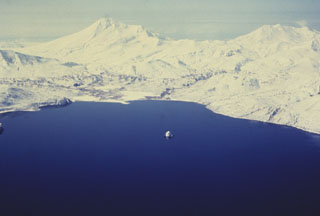 Kambalny (left-center) and Koshelev (far right) volcanoes rise above the Kurile Lake caldera to the SW, one of the scenic highlights of the Kamchatka Peninsula. Kambalny is the southernmost large volcano in Kamchatka. Both volcanoes have produced recent lava flows from flank vents on complex older structures. The small island in Kurile Lake caldera is the "Heart of Alaid," a rhyolitic lava dome.
Kambalny (left-center) and Koshelev (far right) volcanoes rise above the Kurile Lake caldera to the SW, one of the scenic highlights of the Kamchatka Peninsula. Kambalny is the southernmost large volcano in Kamchatka. Both volcanoes have produced recent lava flows from flank vents on complex older structures. The small island in Kurile Lake caldera is the "Heart of Alaid," a rhyolitic lava dome.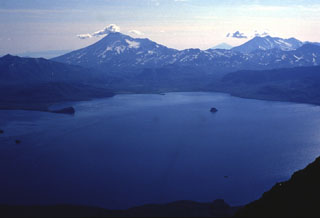 Kambalny (left) and Koshelev (right) rise above the SW shore of Kurile Lake caldera at the southern tip of Kamchatka. The caldera formed in two stages, the first about 41,500 radiocarbon years ago and the second about 7,600 years ago during one of Kamchatka's largest Holocene eruptions. The small island (right-center) is the lava dome referred to as the "Heart of Alaid”. The peak on the distant horizon at right-center is Alaid in the Kuril Islands.
Kambalny (left) and Koshelev (right) rise above the SW shore of Kurile Lake caldera at the southern tip of Kamchatka. The caldera formed in two stages, the first about 41,500 radiocarbon years ago and the second about 7,600 years ago during one of Kamchatka's largest Holocene eruptions. The small island (right-center) is the lava dome referred to as the "Heart of Alaid”. The peak on the distant horizon at right-center is Alaid in the Kuril Islands.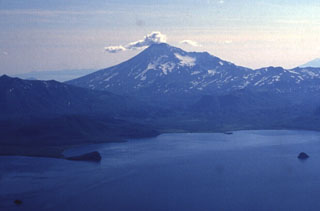 Kambalny is the southernmost large volcano on the Kamchatka peninsula, seen here above the SW shores of Kurile Lake caldera. There are scoria cones and lava flows on the W and SE flanks that suggest the possibility of very recent eruptions. Active fumarolic areas are found on the flanks.
Kambalny is the southernmost large volcano on the Kamchatka peninsula, seen here above the SW shores of Kurile Lake caldera. There are scoria cones and lava flows on the W and SE flanks that suggest the possibility of very recent eruptions. Active fumarolic areas are found on the flanks.Maps are not currently available due to technical issues.
There are no samples for Kambalny in the Smithsonian's NMNH Department of Mineral Sciences Rock and Ore collection.
| Copernicus Browser | The Copernicus Browser replaced the Sentinel Hub Playground browser in 2023, to provide access to Earth observation archives from the Copernicus Data Space Ecosystem, the main distribution platform for data from the EU Copernicus missions. |
| MIROVA | Middle InfraRed Observation of Volcanic Activity (MIROVA) is a near real time volcanic hot-spot detection system based on the analysis of MODIS (Moderate Resolution Imaging Spectroradiometer) data. In particular, MIROVA uses the Middle InfraRed Radiation (MIR), measured over target volcanoes, in order to detect, locate and measure the heat radiation sourced from volcanic activity. |
| MODVOLC Thermal Alerts | Using infrared satellite Moderate Resolution Imaging Spectroradiometer (MODIS) data, scientists at the Hawai'i Institute of Geophysics and Planetology, University of Hawai'i, developed an automated system called MODVOLC to map thermal hot-spots in near real time. For each MODIS image, the algorithm automatically scans each 1 km pixel within it to check for high-temperature hot-spots. When one is found the date, time, location, and intensity are recorded. MODIS looks at every square km of the Earth every 48 hours, once during the day and once during the night, and the presence of two MODIS sensors in space allows at least four hot-spot observations every two days. Each day updated global maps are compiled to display the locations of all hot spots detected in the previous 24 hours. There is a drop-down list with volcano names which allow users to 'zoom-in' and examine the distribution of hot-spots at a variety of spatial scales. |
|
WOVOdat
Single Volcano View Temporal Evolution of Unrest Side by Side Volcanoes |
WOVOdat is a database of volcanic unrest; instrumentally and visually recorded changes in seismicity, ground deformation, gas emission, and other parameters from their normal baselines. It is sponsored by the World Organization of Volcano Observatories (WOVO) and presently hosted at the Earth Observatory of Singapore.
GVMID Data on Volcano Monitoring Infrastructure The Global Volcano Monitoring Infrastructure Database GVMID, is aimed at documenting and improving capabilities of volcano monitoring from the ground and space. GVMID should provide a snapshot and baseline view of the techniques and instrumentation that are in place at various volcanoes, which can be use by volcano observatories as reference to setup new monitoring system or improving networks at a specific volcano. These data will allow identification of what monitoring gaps exist, which can be then targeted by remote sensing infrastructure and future instrument deployments. |
| Volcanic Hazard Maps | The IAVCEI Commission on Volcanic Hazards and Risk has a Volcanic Hazard Maps database designed to serve as a resource for hazard mappers (or other interested parties) to explore how common issues in hazard map development have been addressed at different volcanoes, in different countries, for different hazards, and for different intended audiences. In addition to the comprehensive, searchable Volcanic Hazard Maps Database, this website contains information about diversity of volcanic hazard maps, illustrated using examples from the database. This site is for educational purposes related to volcanic hazard maps. Hazard maps found on this website should not be used for emergency purposes. For the most recent, official hazard map for a particular volcano, please seek out the proper institutional authorities on the matter. |
| IRIS seismic stations/networks | Incorporated Research Institutions for Seismology (IRIS) Data Services map showing the location of seismic stations from all available networks (permanent or temporary) within a radius of 0.18° (about 20 km at mid-latitudes) from the given location of Kambalny. Users can customize a variety of filters and options in the left panel. Note that if there are no stations are known the map will default to show the entire world with a "No data matched request" error notice. |
| UNAVCO GPS/GNSS stations | Geodetic Data Services map from UNAVCO showing the location of GPS/GNSS stations from all available networks (permanent or temporary) within a radius of 20 km from the given location of Kambalny. Users can customize the data search based on station or network names, location, and time window. Requires Adobe Flash Player. |
| DECADE Data | The DECADE portal, still in the developmental stage, serves as an example of the proposed interoperability between The Smithsonian Institution's Global Volcanism Program, the Mapping Gas Emissions (MaGa) Database, and the EarthChem Geochemical Portal. The Deep Earth Carbon Degassing (DECADE) initiative seeks to use new and established technologies to determine accurate global fluxes of volcanic CO2 to the atmosphere, but installing CO2 monitoring networks on 20 of the world's 150 most actively degassing volcanoes. The group uses related laboratory-based studies (direct gas sampling and analysis, melt inclusions) to provide new data for direct degassing of deep earth carbon to the atmosphere. |
| Large Eruptions of Kambalny | Information about large Quaternary eruptions (VEI >= 4) is cataloged in the Large Magnitude Explosive Volcanic Eruptions (LaMEVE) database of the Volcano Global Risk Identification and Analysis Project (VOGRIPA). |
| EarthChem | EarthChem develops and maintains databases, software, and services that support the preservation, discovery, access and analysis of geochemical data, and facilitate their integration with the broad array of other available earth science parameters. EarthChem is operated by a joint team of disciplinary scientists, data scientists, data managers and information technology developers who are part of the NSF-funded data facility Integrated Earth Data Applications (IEDA). IEDA is a collaborative effort of EarthChem and the Marine Geoscience Data System (MGDS). |